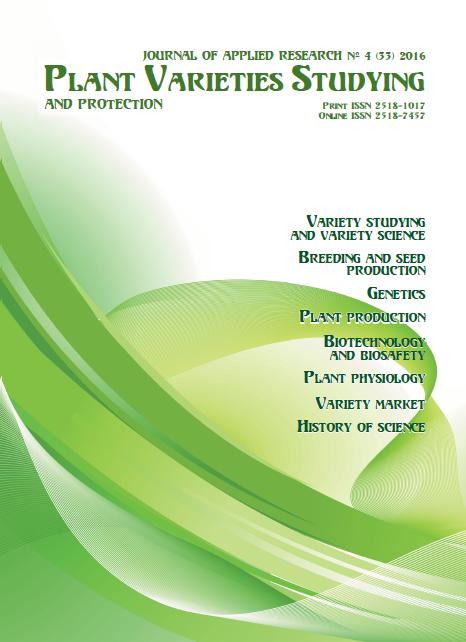Selection bases of developing new varieties of willow family (Salicaceae Mirb.) to create energy plantations
DOI:
https://doi.org/10.21498/2518-1017.4(33).2016.88607Keywords:
selection process, genus Salix L., genus Populus L., varietal plant breeding, algorithm of perspective form selectionAbstract
Purpose. To develop an algorithm of creation of new highly productive clonal varieties of Salicaceae family representatives with improved agronomic characters that can be used at energy plantations
Methods. Field investigations, laboratory analysis, analytical approach, selection method.
Results. Flow chart of selection process with representatives of Salicaceae family included the following stages: the Ist stage – creation of primary families (F0); the IInd stage – creation of the second families, or branches; the 222rd stage – interfamily (individually-familial) selection; IVth stage – familial-group selection; the Vth stage – clonal selection (selection of ramets).
Conclusions. Breeding process with the use of complex of advanced methods of selection (individual, familial, group and clonal ones) allows to get model populations with high-frequency of valuable alleles and genotypes and with the high level of genetic variety. Due to a negative multi-stage individual intrafamilial and interfamily selection, cleaning of artificial populations from undesirable forms takes place without the substantial decrease of genetic variety level.
Downloads
References
Afonin, A. A. (2005). Metodologicheskie printsipy sozdaniya ustoychivykh vysokoproduktivnykh nasazhdeniy iv (na primere avtokhtonnykh vidov Bryanskogo lesnogo massiva) [Methodological principles of creation of the steady highly productive plantations of willows (a study of autochthonic species of the Bryansk forest area)]. Bryansk: RIO Bryanskogo gosudarstvennogo universiteta. [in Russian]
Barna, M. M. (2002). Reproduktyvna biolohiia vydiv i hibrydiv rodyny Verbovykh (Salicaceae Mirb.) [Reproductive biology of species and hybrids of the family Salicaceae Mirb.] (Extended Abstract of Dr. Biol. Sci. Diss.). M. H. Kholodny Institute of Botany, NAS of Ukraine, Kyiv, Ukraine. [in Ukrainian]
Heletukha, H. H., & Martsenyuk, Z. A. (1998). Energeticheskiy potentsial biomassy v Ukraine [Energy potential of biomass in Ukraine]. Promyshlennaya teplotekhnika [Industrial Heat Engineering], 20(4), 52–55. [in Russian]
Gorelov, A. M., Fuchylo, Ya. D., Krugliak, Yu. M., Viriovka, V. M., & Gorelov, A. A. (2014). Hibrydyzatsia ta selektsia verb yak perspektyvnyi napriam otrymannia vysokoprodyktyvnykh kloniv [Willows hybridization and breeding as a promising trend of highly productive clones obtaining]. Lisivnytstvo i agroli-somelioratsiya [Forestry & Forest Melioration], 125, 108–114. [in Ukrainian]
Starova, N. V. (1980). Selektsiya ivovykh [Breeding of Salicaceae]. Moscow: Lesnaya promyshlennost. [in Russian]
Fuchylo, Ya. D., & Sbytna, M. V. (2009). Verby Ukrainy (biolohiia, ekolohiia, vykorystannia) [Willows of Ukraine (biology, ecology, use)]. Kyiv: Lohos. [in Ukrainian]
Tsarev, A. P., Pogiba, S. P., & Trenin, V. V. (2003). Selektsiya i reproduktsiya lesnykh drevestnykh porod [Breeding and reproduction of forest timber species]. Moscow: Logos. [in Russian]
El Bassam, N. (2012). Handbook of Bioenergy Crops: A Complete Reference to Species, Development and Applications. London/ Washington, DC: Earthscan.
Chmelar, J., & Meusel, W. (1976). Die Weiden Europas. Wittenberg-Lutherstadt: Ziemsen.
McCracken, A. R., & Dawson, W. M. (1998). Interaction of willow (Salix) clones growing in mixtures. Tests of Agrochemicals and Cultivars, 19, 54–55.
Caslin, B., Finnan, J., & McCracken, A. (Eds.). (2012). Willow Varietal Identification Guide. Carlow, Ireland : Teagasc.
Wright, J. W. (1976). Introduction to Forest Genetics. New York, USA: Academic Press.
Downloads
Published
How to Cite
Issue
Section
License
Copyright (c) 2016 Ukrainian Institute for Plant Variety Examination

This work is licensed under a Creative Commons Attribution-ShareAlike 4.0 International License.
Starting in 2022, the copyright to the publication remains with the authors
Our journal abides by the CREATIVE COMMONS copyright rights and permissions for open access journals.
Authors, who are published in this journal, agree to the following conditions:
- The authors reserve the right to authorship of the work and pass the first publication right of this work to the journal under the terms of a Creative Commons Attribution License, which allows others to freely distribute the published research with the obligatory reference to the authors of the original work and the first publication of the work in this journal.
- The authors have the right to conclude separate supplement agreements that relate to non-exclusive work distribution in the form in which it has been published by the journal (for example, to upload the work to the online storage of the journal or publish it as part of a monograph), provided that the reference to the first publication of the work in this journal is included.

























 Ukrainian Institute for Plant Varieties Examination
Ukrainian Institute for Plant Varieties Examination  Селекційно-генетичний інститут
Селекційно-генетичний інститут Institute of Plant Physiology and Genetics of the National Academy of Sciences of Ukraine
Institute of Plant Physiology and Genetics of the National Academy of Sciences of Ukraine
 The National Academy of Agrarian Sciences of Ukraine
The National Academy of Agrarian Sciences of Ukraine